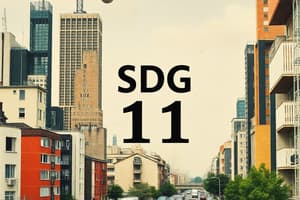Podcast
Questions and Answers
What can lead to increased farmer income but also inflation and land shortages?
What can lead to increased farmer income but also inflation and land shortages?
- Incentives for sustainable food production
- Lower prices for staple foods
- Urbanization
- Higher food prices (correct)
What is expected to reach 9.7 billion by 2050, posing challenges for poor nations?
What is expected to reach 9.7 billion by 2050, posing challenges for poor nations?
- Higher food prices
- Incentives for sustainable food production
- Urbanization
- World population (correct)
What may decrease hunger but increase malnutrition?
What may decrease hunger but increase malnutrition?
- Incentives for sustainable food production
- Higher food prices
- Urbanization
- Lower prices for staple foods (correct)
What can lead to obesity and decreased manual labor?
What can lead to obesity and decreased manual labor?
Which country is a major agricultural exporter but is not self-sufficient in food production?
Which country is a major agricultural exporter but is not self-sufficient in food production?
What does Dutch food consumption shifting towards?
What does Dutch food consumption shifting towards?
What requires a multi-sectoral approach and government responsibility?
What requires a multi-sectoral approach and government responsibility?
What is lacking, leading to challenges in sustainable food production and consumption?
What is lacking, leading to challenges in sustainable food production and consumption?
What is insufficient, requiring data analysis?
What is insufficient, requiring data analysis?
What are crucial in preventing food crises?
What are crucial in preventing food crises?
What is the main focus of SDG 2?
What is the main focus of SDG 2?
According to Hendriks (2018), what is the main change in SDG 2 compared to the old system?
According to Hendriks (2018), what is the main change in SDG 2 compared to the old system?
What is identified as one of the problems in the old system according to Hendriks (2018)?
What is identified as one of the problems in the old system according to Hendriks (2018)?
Which regions are mentioned as having concentrated hunger problems?
Which regions are mentioned as having concentrated hunger problems?
What has been the trend in undernourishment since 2019 according to the text?
What has been the trend in undernourishment since 2019 according to the text?
What is emphasized as a requirement for addressing food supply chain issues?
What is emphasized as a requirement for addressing food supply chain issues?
What is one of the changing consumption patterns due to awareness of health and sustainability mentioned in the text?
What is one of the changing consumption patterns due to awareness of health and sustainability mentioned in the text?
What is one of the high costs mentioned in relation to obesity and diabetes?
What is one of the high costs mentioned in relation to obesity and diabetes?
What is one of the nature-related challenges faced in the Netherlands according to the text?
What is one of the nature-related challenges faced in the Netherlands according to the text?
What is one of the future prospects mentioned for the Netherlands?
What is one of the future prospects mentioned for the Netherlands?
What is one of the market failure issues highlighted in the text?
What is one of the market failure issues highlighted in the text?
What is one of the challenges related to the quality of nature in the Netherlands according to the European Commission?
What is one of the challenges related to the quality of nature in the Netherlands according to the European Commission?
Flashcards are hidden until you start studying
Study Notes
Challenges in Global Food Production and Distribution
- Incentives for sustainable food production and consumption are lacking
- Higher food prices can lead to increased farmer income but also inflation and land shortages
- Higher incomes may not necessarily lead to higher food consumption
- Lower prices for staple foods may decrease hunger but increase malnutrition
- Urbanization can lead to obesity and decreased manual labor
- World population is expected to reach 9.7 billion by 2050, posing challenges for poor nations
- The issue of malnutrition requires a multi-sectoral approach and government responsibility
- Theoretical knowledge is insufficient, and data analysis is needed
- Distribution, ownership, and exchange possibilities are crucial in preventing food crises
- The Netherlands is a major agricultural exporter, but it is not self-sufficient in food production
- The country's agriculture is technology-dependent and focused on efficiency
- Dutch food consumption is shifting towards health and environmental awareness and a more plant-based diet
Studying That Suits You
Use AI to generate personalized quizzes and flashcards to suit your learning preferences.




